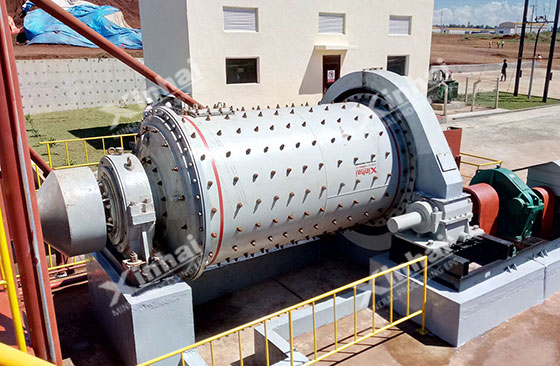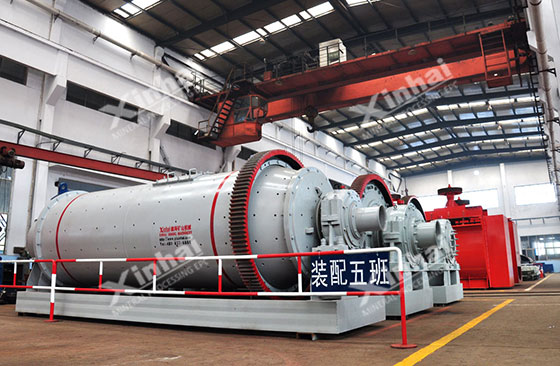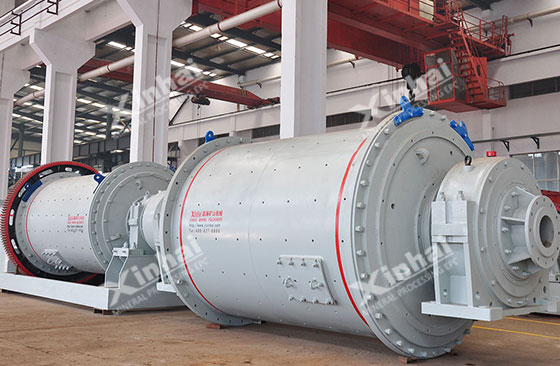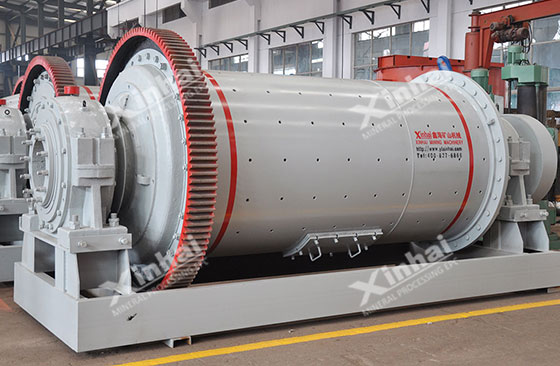
When the ball mill works stably, the amount of material entering the ball mill is basically equal to the amount of material discharged from the ball mill. But sometimes, some reasons (such as the amount of returning sand increase, the amount of raw ore increase) will lead to the amount of material fed into the ball mill increased, which beyond the maximum capacity that ball mill allows, so that the material accumulates in the ball mill gradually and cannot be discharged, then lose its grinding effect. This phenomenon is called the overage grind of ball mill.
But, do you know what the harm of overage grind is? What is the reason that led to the overage grind of ball mill? And how do we judge it timely and accurately? how to solve this problem?
The harm of overage grind mainly includes two aspects:
1. The problem of overage grind will make the ball mill reduce or even lose the grinding effect on the ore, and destroy the stable work of the ball mill. Meanwhile, dealing with the overage grind will also affect the ore quality fraction and grinding fineness of the subsequent separation operation, and hinder the normal operation of the separation operation.
2. If the problem of overage grind is too serious, the ball mill will be destroyed. For example, when the overflow type ball mill suffers serious overage grind, the large ore and steel ball will spit out from the feed port and discharging port. Especially in the closed-circuit grinding, the overflow type ball mill will make a mass of steel ball and ore blocks enter the sand return box. The large ore blocks and steel balls slam into the scoop feeder, which will damage the feeder and sand return box, make the spoon head fall off or the bolt that connects the feeder with hollow shaft deforms, and destroy the concentricity of the feeder and hollow shaft, even lead the ball mill to vibration.

According to the nature of overage grind, the overage grind of a ball mill can be divided into "dry overage grind" and "wet overage grind" two kinds. No matter what kind of overage grind is, the main reason is mainly caused by improper operation except for ore nature (hardness) and steel ball addition system.
1. Excessive feeding capacity
No matter which grinding method is adopted, it is necessary to abide by the balance rule of materials-in and materials-out for obtaining a stable grinding process, that is, the full feeding capacity of the ball mill (the original feeding capacity and the output of return ores) is equal to the amount of ore discharging. When the full feeding capacity of ball mill exceeds the amount of ore discharging, the balance rule of material-in and material-out is destroyed, so the problem of overage grind happens.
2. The feed size coarsens
When the composition of feed size changes and the content of coarse material increases, the ball mill cannot maintain the stable operation and lead to overage grind if the feed quantity is not adjusted in time. Because the material that is ground to the specified fineness need to maintain a certain amount of detention time in the ball mill, and the coarse material in the ball mill will accumulate more and more, thus resulting in overage grind if the feeding capacity is not reduced timely.
3. Too much circulating load
In the closed-circuit grinding, the unqualified coarse particles will be classified continuously from the classifying equipment and then return to the ball mill for re-grinding (the returned coarse particles are called sand returned). Appropriately increasing the sand return in a certain range is conducive to increase the ability of ball mill, but too much circulating load will destroy the balance principle due to improper operation, thus resulting in the overage grind of ball mill.
4. Supplementary water amount changes
Adding the wash water of mill discharge, the wash water of sand return and the feed water of ball mill in the grinding - classifying circuit. The change of wash water of mill discharge will lead to the change of overflow fineness and circulating load, thus affecting the full feeding capacity of ball mill, while the wash water of sand return and the feed water of ball mill will directly affect the grinding concentration. Therefore, some reasons (water pressure reduces, water pipe blocks) will lead to the decreasing of the supplementary water amount, so too high grinding concentration makes the material cannot be discharged, thus resulting in the overage grind of ball mill.

In fact, the problem of overage grind doesn't happen suddenly, which is commonly associated with various abnormal phenomena in the process. So, the ball mill operator must be careful to observe the running condition of ball mill, find the problems timely and then adjust it corresponding, eliminate this problem in the mild stage.
Specifically, the ball mill operator can judge the problem from the following three aspects:
1. Observe the current
When the ball mill is in normal operation, the ammeter pointer indicating the current of its main motor will always swing in a small range, which indicates that the change of current is small.
Once the problem of overage grind occurs, the motion range of the medium is relatively small because the amount of material in the ball mill is increased, the effective space occupied by a mass of materials. The useful work improving the medium decreases, and the barycenter of ball mill load (medium and ore) rises, that is, the distance deviates from the ball mill center is shortened, the resisting moment produced by eccentricity is reduced, the required power that overcomes the resisting moment is decreased, the total energy consumption of ball mill is reduced, then the current reading will be reduced.
The more serious the problem is, the more the current decreases. Therefore, the ball mill operator should adjust it timely once the current decreases gradually.
2. Listen to the sound
When the ball mill runs, the sound from the ball mill mainly comes from the transmission mechanism itself and the collision among the medium, ore and ball mill liner. The size of the collision sound will change with the amount of material in the ball mill.
When the problem of overage grind occurs, the ball mill is filled with high-quality fractional slurry, the impact effect among the medium, ore and ball mill liner is weakened by the viscous slurry, and the sound is gradually dull. In severe cases, the sound inside the cylinder almost disappears and only a buzzing sound can be heard from other aspects.
Therefore, the problem of the overage grind can be founded from the sound change.
3. Measure the concentration and observe the discharging
When the ball mill is in normal operation, its discharging mass fraction and discharging amount basically remain stable. But when the problem of overage grind occurs, its discharging mass fraction starts to rise, and the discharging amount becomes larger, the particle size becomes coarser. In severe cases, the material cannot be discharged due to excessive concentration and poor liquidity.
Therefore, the problem of the overage grind can be founded by the change of discharging concentration, particle size and discharging amount.

Due to the different grinding process, the nature and reason of overage grind, the methods adopted to deal with the problem of overage grind are not the same. But whatever the reason, the first thing is to stop feeding, then adopt the necessary treatment according to the specific situation:
● For open circuit grinding:
After the ore feeding is stopped, only increasing the feeding water appropriately can make the material discharge from the ball mill slowly, so the problem of the overage grind can be eliminated.
● For closed circuit grinding:
The feeding consists of original ore feeding and sand return of classifier two parts. If only stop the original ore feeding, the sand return will continue to feed into the ball mill, so the problem of the overage grind cannot be solved. At this time, reduce the amount of sand return as soon as possible, stop the ore feeding, appropriately reduce the supplementary water of ball mill discharging and increase the wash water of sand return and the feed water of ball mill. At this time, the ore concentration in the ball mill will be decreased, and the mobility will be increased, which accelerates the material discharging, so the problem of the overage grind can be eliminated.
● For closed circuit grinding composed of the screen:
When the problem of overage grind is serious, the coarse ore can be stored in accident pool temporarily and then pump it back for re-grinding after it returns to normal.
● If the problem of overage grind is serious:
After the ball mill returns to normal, stop the ball mill for necessary inspection: the spoon head, feeder, screw and other parts of the ball mill.

In a word, the problem of overage grind is a common problem that many concentrators will encounter in the production. It is suggested that the ball mill operators must pay more attention to the operation of the ball mill, take the appropriate measures to deal with the problem of the overage grind after analyzing the reasons, thus ensuring the normal production of the concentrator.
To find out more about our products and solutions, please fill out the form below and one of our experts will get back to you shortly.